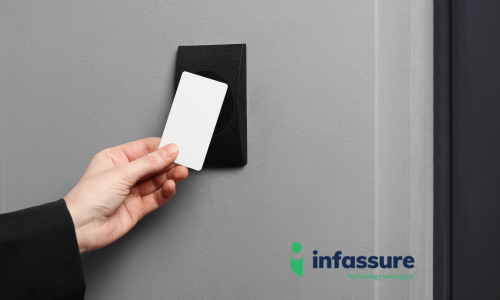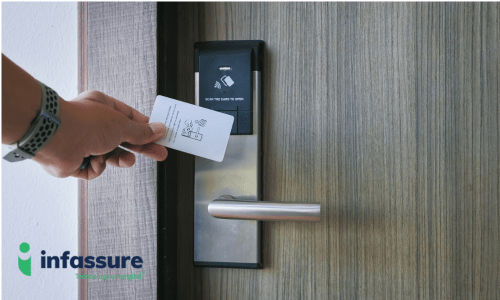Smart card technology has become increasingly common in the modern world. Smart carders use RFID (Radio Frequency Identification) technology to read and process information stored within the chip embedded into an ID card. You might be familiar with the concept if you have a modern debit or credit card, but smart cards are used in a range of other environments too.
In the access control landscape, smart card readers are extremely common, allowing individuals to enter specific places in a building, and bypass locks using just a small card or badge. The right smart card readers can offer a range of benefits over old-fashioned magstripe systems, and solutions that rely on users entering a PIN or code.
They’re convenient, secure, and easy to use. Plus, they’re more affordable than most people realize. Here’s everything you need to know about the capabilities and benefits of smart card readers.
What is a Smart Card Reader? The Basics
A smart card reader is a device used to read, and process information stored within a “smart card”. They’re used within security systems, for transactions, and even in the travel and transportation landscape. Although smart card readers come in different forms, they’re all used in conjunction with smart cards—simple, plastic cards that house small computer chips.
These computer chips store personal information, such as banking details, or identity credentials. They can also perform data encryption and data validation tasks. However, smart cards on their own have no power supply, meaning they can’t do anything without first being connected to a contactless smart card reader.
With smart card readers, the connection is based on RFID technology. There are two common types of RFID used in the access world: 125KHz, and 13.56MHz. With both of these technologies, the smart card is programmed with a unique number. Within the access control system, a given user is assigned that number, along with rules that outline which doors they can access, at which times, and other crucial details.
When the card is presented to the smart card reader, the system checks the number against its database, to determine whether access is allowed, and unlock a door. These cards can be programmed both by the vendors that provide them, and by the end user, using specialist equipment.
The Different Types of Smart Card Readers
While many people today associate smart card readers with the contactless systems used in hotel security systems, retail locations, and other environments, there are actually three different types of readers to choose from:
Direct Contact Smart Card Reader
A direct contact smart card reader is the most traditional option. In this instance, the reader can only operate when a physical connection is established between the reader, and the chip in a smart card. In some cases, the connection involves swiping a card through a reader or inserting it into a slot.
Data located on a magnetic stripe within the card is then read and sent to a processor that can interact with various applications, such as access control technologies.
Contactless Smart Card Readers
A contactless smart card reader is a slightly more modern solution. Instead of relying on a physical connection with a chip, these readers can collect information using wireless technologies, such as RFID. To successfully communicate, the card needs to be close enough to the reader for the system to pick up the RFID chip’s signal.
The more advanced version of RFID technology, 13.56MHz, can operate at a faster speed than its predecessor, which allows for quicker data processing. This option has become extremely popular, as it’s efficient, effective, and convenient for smart card users.
Combined Card Readers
Some smart card readers include a combination of different types of technology to ensure that transactions and data can be processed either wirelessly, or through a direct connection. This is common in environments where people may not have access to RFID enabled cards, or may prefer to use a direct contact method.
For instance, a hospitality company might equip some employees with wireless cards, which offer access to a wider range of doors and locations, and equip others with more basic direct-contact cards connected to specific doors.

The Benefits of a Smart Card Reader
Smart card readers are essentially an evolution of traditional card reading systems used by companies and retailers in the past. Compared to old-fashioned technologies, smart card readers can offer a lot of distinct benefits, such as:
Greater Security
Although the overall security of a smart card reader will depend on its encryption technologies and the access control systems used by the business, there is a potential for fewer risks. Older RFID smart cards don’t feature encryption, so anyone who finds the card can access the information. However, newer solutions based on 13.56MHz technology do offer greater security.
These cards include encryption technology, so the unique ID of the card cannot be read without a password. This allows for a greater level of security.
Adaptability
Older card reading technologies were often more restricted in terms of their functionality and abilities. Most traditional card readers were only suitable for specific use cases. However, smart card readers can be used for a variety of purposes and adapted to suit the specific needs of each business.
Through USB connections, smart card readers can also be plugged into different machines and integrated with various types of software.
Larger, More Protected Memory
On average, around 150 bytes of data can be stored on a traditional magnetic stripe card. Alternatively, smart cards can hold a lot more information—up to 256KB. This means a chip card can hold significantly more crucial information about a person.
Additionally, once information has been stored in a smart card’s embedded chip, the extra encryption and authentication methods in place mean it is difficult to edit, erase, or delete that data. This leads to a higher overall level of security for companies and their smart card users.
Where are Smart Card Readers Used?
As mentioned above, most people commonly associate smart cards and their readers with the retail and financial landscape. Professional services companies, retailers, and merchants can accept smart cards when processing payments.
However, thanks to their convenience and exceptional security, smart card readers have also become more common in a variety of other environments. They’re used in businesses, offices, government sectors, and other organizations for security and access control purposes. They can also be used in the healthcare sector, for processing health insurance, or in gift and loyalty cards.
Some of the most common example use cases for smart card readers include:
-
- Security: Fobs, cards, and wearable devices are used with smart card readers to manage access in businesses from virtually every industry.
- Education: ID cards in the educational industry can offer secure access to faculty grounds and resources for both staff and students.
- Hospitality: In casinos, hotels, and theme parks, smart card readers are frequently used instead of keys for access controls.
- Medical: In the medical landscape, smart cards, and smart card readers are commonly used to control access to certain parts of a building, and restricted areas.
Notably, the demand for smart cards and smart card readers is also continuing to grow. By 2028, the industry will be worth approximately $25.99 billion.
Do you Need Smart Card Readers in Your Business?
Smart card readers and smart cards are becoming increasingly common in the modern world especially as a means for personal identification. They’re not just essential in everyday transactions, they can also be critical tools in your security and access control strategy, no matter which industry you serve.
At Infassure, we specialize in helping businesses to upgrade their technology systems, offering comprehensive access to everything from structured wiring solutions, to comprehensive AV systems and access control systems.
If you’re planning on implementing a smart card reader into your business, contact the Infassure team to learn more about how you can align your technology with our leading security solutions. Ask about our design, installation, and customer service including technical support today.


